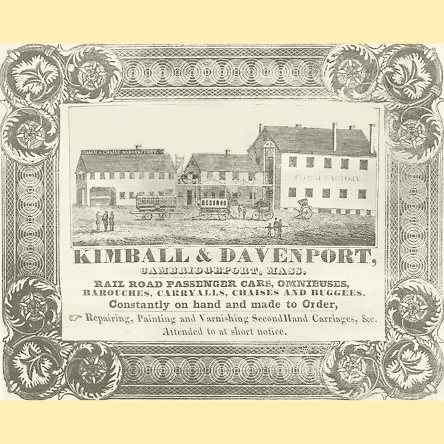 |
|||

|
A train is a staple of modern transportation. Ask even a young child to describe a train, and the description will be generally the same. They may vary slightly from the outside, but on the inside, people sit in rows of seats along both sides of the cars, while passengers, train staff, or anyone else, move through the length of a car along a center aisle. While this may seem obviously simple today, in the past, train cars were much different. Early rail transportation gained attention for its promise of efficiency but certainly not for a promise of comfort. Without being forced to rely on the limited capabilities of horsepower for mobility, trains could go farther, faster, and were quickly surpassing coaches and carriages in popularity for early 19th century travel. To ride in a train car, however, meant sitting on not much more than road coaches mounted on flanged wheels. Often the train’s wheels protruded up into the car itself--a clumsy, dirty, and dangerous arrangement. Even with these drawbacks, the only people who could afford to travel by train were those who had, or had saved, enough money to pay for an exclusive seat in the train’s small compartment. Innovation in train car design is credited to Charles Davenport. Davenport was a young, recently-apprenticed wheelwright working in Cambridge in the early 1800s. After completing his apprenticeship, Davenport joined his friend Ebenezer Kimball, operator of a stage line between Cambridge and Boston, formed the company Kimball & Davenport, and began to make a name for themselves producing carriages and related goods for the rail line. As their company grew, they employed a blacksmith, a painter, a harnessmaker, as well as two journeymen and four apprentices. In 1834 Kimball & Davenport was commissioned to build four-wheeled cars for the Boston & Worcester Railroad. Davenport’s suggestion for how it should be done involved an innovation which revolutionized transportation. The Boston & Worcester Railroad commission required that each of the cars seat 24 passengers. To complete this project, it is described that, “Mr. Davenport designed a car with the passageway running its entire length and permitting the passengers to all face the same way. This was the beginning of the American type of railroad passenger car. The first cars had the entrance door in the center of the body, with a step on both sides running along the entire length of the car, similar to the running board on the later-day open trolley car.” 1 What Charles Davenport had introduced was the center-aisle train car. No longer were there only a few seats in a closed train car compartment, but he had made rows of seats on either side of a central aisle. The practicality of this design was obvious to all, and Davenport’s next iteration of the car saw doors at either end of the car instead of only in the center. With comfort and ease of travel a revealed priority for rail travel, ladies washrooms and toilets began to be included in train construction as well. While the physical design of the center-aisle train car was revolutionary for its increased efficiency, it also had major social consequences for travelling. A person no longer needed to pay for an entire compartment to travel, or even one of a few expensive seats. With rows of identical seats, anyone who could afford a single ticket could travel, and people all sat together as equals in the car. Davenport’s partner Ebenezer Kimball died in 1839, and Davenport soon partnered with his son-in-law Albert Bridges to form Cambridge’s car-building powerhouse of Davenport & Bridges, which remained the leading manufacturer of railroad cars in the United States for the next twenty years. In 1842, the Davenport & Bridges works moved to the south side of Main Street, where they occupied the entire block between Portland Street and Osborn Street. Their factory, the largest in Cambridge at the time, was described in the American Railroad Journal in 1848: The factory of Davenport and Bridges built some of the most luxurious and expensive train cars of the era. The company was even commissioned by the Untied States government to build “100 baggage wagons” during the Mexican War. Later in his career, Davenport split from Albert Bridges. In 1854 he opened the Davenport Car Works at 708 Main Street, Cambridge. The following year, he retired a wealthy man of only 43, and sold his company to Caleb Allen and Henry Endicott. Davenport spent the rest of his days traveling the United States and around the world. The importance of Davenport’s innovation has perhaps been obscured by its omnipotence. Nevertheless, the center-aisle train car is an immensely important innovation which has forever altered how the world travels. Sources: |
||

